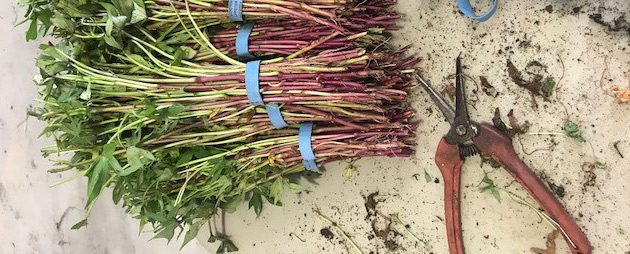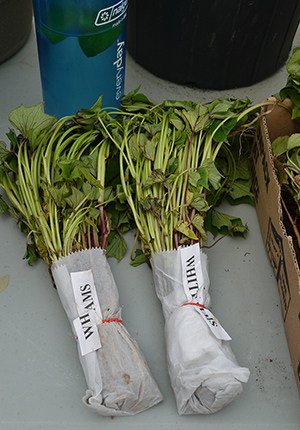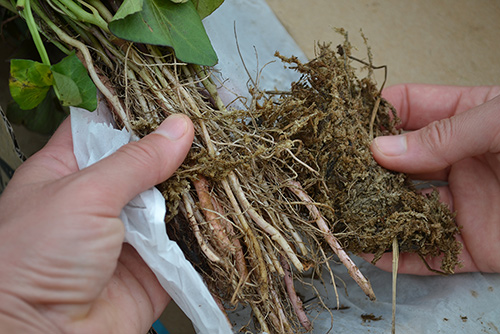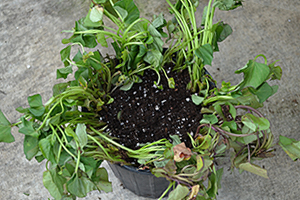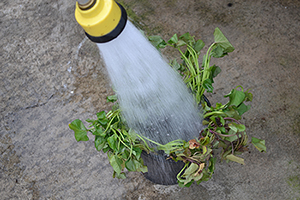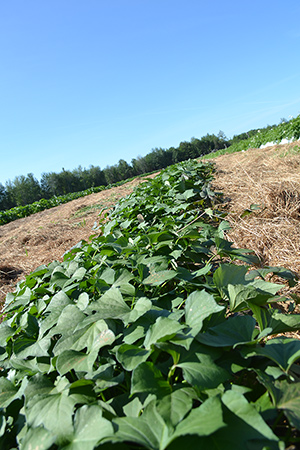- Video: Planting Sweet Potatoes | Tutorial from Johnny's Selected Seeds
- Sweet Potatoes | Key Growing Information
- Classic Storage Crops | Post-Harvest Handling & Storage Guidelines
- Tips for Starting Your Sweet Potato Slips | Recommendations from Johnny's Trialing Team
- Sweet Potatoes | Instructions for Growing from Slips | Tech Sheet (PDF)
Easy-to-follow recommendations from our field trials
Although native to the American tropics, sweet potatoes are an important crop that is grown globally in diverse ecologies. Even though they are extremely frost-sensitive, they can be grown successfully from slips in cooler climates, provided a few key conditions are met.
Here at Johnny's, orders of sweet potato slips ship at a steady clip in the springtime. The slips are shoots that have been sprouted from seed stock roots. If you have never grown sweet potatoes from slips before, here's a set of illustrated steps to help ensure your crop takes off from the get-go. We explain how to hold them over until you are able to plant, then walk you through bed prep, dibbling in the slips, and adding a layer of protective row cover for this heat-loving crop. Photos from a recent trial at our research farm illustrate what to expect and do, to be certain your crop is on track for a banner yield come fall.
Arrival & Preplanting Care
With any shipment of live plants, the general rule is to plant them in their final spot as soon as possible. But in the case of sweet potatoes, it's better to bend the rules when inclement weather or life in general intervene. If you're held back from planting right away, here's how to keep your sweet potato slips healthy until you can get them in the ground.
First of all, open the box as soon as it arrives. The rigors of packing and shipping can leave live plant material looking the worse for wear. The slips may look like nothing more than sticks. Some of the leaves may be pale, wilted, dried up, or even dead. There may be absolutely no leaves. But this is not usually cause for alarm — plant tissue can be significantly more resilient than outward appearances might suggest.
There can be variation between the slips in length and diameter, as well as in the extent of the finer fibrous white roots that may be growing off of them. This, too, is normal — both for different varieties and the same variety. Some slips will have no fibrous roots, some will have many, some will have brand new, bright-white fibrous roots sprouting from the nodes. A lack of roots is not going to negatively impact yield or viability.
They will all grow if planted in a favorable environment. Many commercial sweet potato growers, who plant thousands of acres each year, prefer to plant bare-root slips. There are fewer variables when the tissue is bare; the process is cleaner, and avoids transfer of soil from farm to farm.
Holding Your Slips for a Day or Two
If you anticipate that it will be only a day or two before you can plant them, moisten a paper towel or clean cloth rag and wrap it loosely around the root ends of the slips. Keep in mind there is additional risk of accidental damage each time the plants are handled. If the slips have no fibrous roots, simply wrap the moist towel around the cut ends of the slips.
Protect the slips from direct sunlight, and prop them upright. We stick each bundle in a glass or jar if we expect to be planting them within a day or so.
Soak the root ends in water for just 1 hour per day — any longer can induce rot.
Being native to the tropics, sweet potato slips do not fare well when held at temperatures below 60°F/16°C. It's best to keep them at around room temperature — generally taken to be about 70°F/21°F.
Holding Your Slips for More Than a Couple Days
We were unable to immediately plant our trial due to the cool wet spring, so to keep them happy until conditions improved, our slips received some long-term care. If you need to hold your slips for more than a couple days, here's what to do.
After opening the box, lift out the bundle and gently and loosely separate the roots from one another, discarding any peat moss that may have been wrapped around the roots before the plants were shipped.
Fill a clean plant pot halfway with potting mix or other sterile planting medium. Arrange the slips loosely around the perimeter of the container, then fill the container to the top with additional potting mix.
Water the slips in to bring the roots into contact with the potting medium, and add more medium if needed. If the slips have fibrous roots, it's important to be sure they are well-covered by the potting mix.
Store the slips at room temperature, out of direct sunlight. We placed ours underneath an occupied greenhouse bench.
If you are holding more than one sweet potato variety, as we were, be sure to keep the varieties separate and label containers accordingly.
Keep the containers moist. In just a day or two, they will begin to flourish with bright, healthy leaves. Rest assured that in the days between their arrival and the day of planting, your sweet potatoes slips will have recuperated, and will indeed look great!
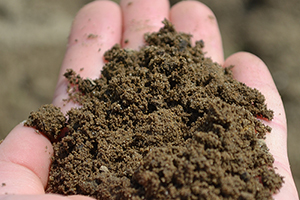
Site Selection & Preparation
A key basis for success with any field-grown crop is that it is well-matched to the soil type. With sweet potatoes, the ideal is a well-drained, sandy loam.
Equally important is that the soil needs to be warm for this tropical native. For our trial here in Central Maine, we laid black plastic mulch along the entire length of our bed as an economical way to both warm the soil and suppress weeds. For maximum soil warming with weed suppression, you can also use solar mulch.
Underneath the mulch we ran a line of tubing to allow for drip irrigation when needed, later in the season.
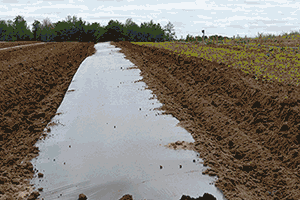
If you're planning to put in a large crop of sweet potatoes, a transplanting tractor can save you considerable time. But ours was a relatively small planting this year, so we put ours in the ground by hand.
Prior to planting, we sunk premarked field stakes at the ends of each row, to identify the varieties and other trial particulars. We then rolled out our measuring tape and punctured holes in the plastic every 12", so each transplant would be equidistant from its neighbors.
We went with this standard, 12" spacing this year, but there has been some research to evaluate the effects of different in-row plant spacing and other factors on sweet potato yield. Wider spacing is generally correlated with larger tubers, and vice versa. If you are curious, you may want to look into the results. You can also check with your local extension agency for recommendations tailored to your regional conditions.
Now Plant
With the field stakes in place and the mulch holes punctured, it's time to begin planting.
If you've potted up your slips to hold them over for a while, remove them from their container as you would with any transplant. Then, gently pry apart the slips to separate them individually. Even during a relatively short holding period, they will have begun to develop a more robust root system.
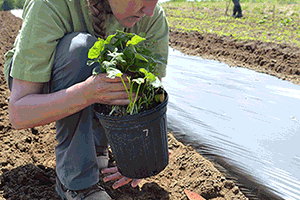
The next step is to create a hole in the soil deep enough to accommodate each slip, one by one, as they can vary in length. To ensure consistent yield, make sure that at least two of the nodes at the base of the slip are planted below the soil line.
If the slips have a lot of fibrous roots, try to bury them below the soil line. There are various ways to accomplish this, but we find it easiest to use a simple wooden dibble.
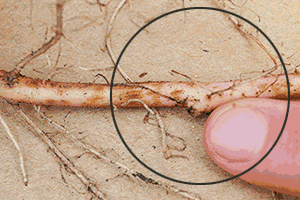
Gauge each slip's length and the breadth of its fibrous roots, then drive the dibble down into the soil and rotate it to widen the hole. This will give you a hole approximately correct in size, as simple as that.
Place just one slip in each hole, with at least 4–6" of its root end buried. If you do find that some of the slips are too long to dibble a hole of sufficient depth, trim off a bit of excess root from the bottom.
Because the top growing point of the slip may not be present, it may or may not be obvious which end of the slip is the root end. Indicators of the root end include greater thickness and the presence of nodes that tend to root-out first. The bottom end can also be identified as the direction opposite to that in which any leaf petioles may be growing.
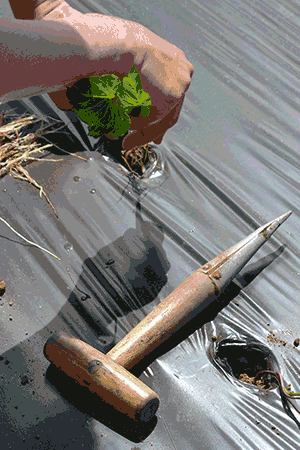
With the slip in the hole, gently push the surrounding soil back into the hole. Firm it in with a thorough watering to provide the plants with needed moisture. It is vital that they be watered in immediately after planting and until established, which can take a week or more.
Again, the plants may look droopy or wilted from the whole process. Transplanting can cause shock to any type of plant, especially if conducted on a hot sunny day like the one on which we planted our trial. Windy conditions, too, even a light breeze, can present additional stress, mechanical in nature as well as by increasing the plants' rate of respiration. Just keep the bed watered and give your plants time to re-establish themselves.
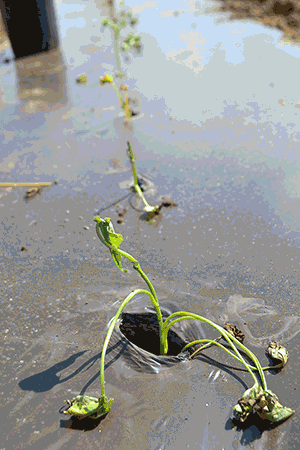
Oftentimes the existing slip foliage will wither and die back, but new foliage will emerge. It can take up to one month before the plants really get growing here in Maine, especially if the weather is cool and overcast.
Row Cover: An Added Layer of Protection
Due to the unpredictable nature of our northern spring weather, we laid a type of row cover known as Agribon over our planting. Made of permeable spun-bonded fabric, Agribon can be very helpful to growers at higher latitudes, acting like a blanket to keep the plants warmer as they become established.
We used Agribon-19, the thickness that is light enough to be laid over plants without hoops or frames, and strong enough to withstand light to moderate wind and other stress. Although we have used it successfully without hoops in the past, frequent windy weather that caused the billowing row cover to jostle the slips prompted us to set up QuickHoops beneath the cover.
The row cover can stay on until the plants are established, which for us was around the 4th of July. We then rolled up the covers and stored them away until the end of summer, when we put them back on to extend the growing window.
Critters Love Sweet Potatoes
Sweet potato leaves are high in protein (ranging from 25–30%, similar to legumes), so if you have deer in your area, take note that they love sweet potato leaves and vines. Rabbits, too, enjoy them, and will slice the shoots clean off with their sharp incisors. If you don't have a fence, a layer of row cover can deter them from feeding on the plants. Voles also have a penchant for the tender young shoots of sweet potatoes and if unchecked can make quick work of the entire crop, so keep an eye out and if need be install ¼" or smaller mesh fencing around the garden to protect the entire area. Plantskydd, a repellent approved for use in organic production, comes in a range of sizes and formulations that can be applied to discourage problematic critters such as deer, rabbits, mice, and voles.
At the close of our transplanting day back in early June, many of the slips were severely wilted — far from healthy appearing. After a few weeks we checked back to see whether or not the vines had taken off.
As explained above, we'd covered them with AG-19 row cover to protect them from the weather, which can remain cool during late spring and into midsummer. The row cover had been removed in early July, and as you can see in the photos, the vines that looked questionable back in June were now fully viable and healthy. The foliage was a lush green, and there was little evidence of pests and none of disease. Due to the cool summer we were having, however, the plants were not as vigorous and sprawling here in Central Maine as they would have been in warmer growing zones.
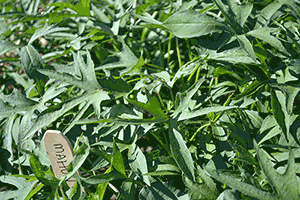
For those of you growing our more recently added variety, 'Mahon Yam™', you will notice something different about its leaves in comparison to other sweet potatoes you may have grown in the past.
Standard sweet potatoes have moderately lobed palmate or cordate leaves. In contrast, 'Mahon Yam' has very deeply lobed leaves, resembling those of Japanese maples.
No matter which leaf type your sweet potatoes produce, if given proper care and growing conditions the plants will yield storage roots for you to enjoy at harvest time.
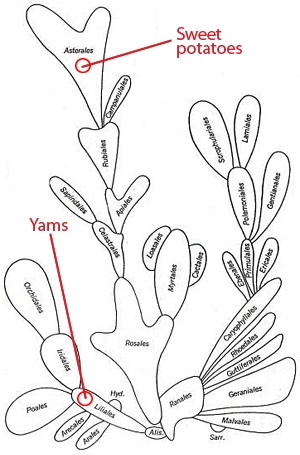
Many different plants around the world are referred to as yams, most notably the sweet potato, but these two crops are from widely divergent plant families. While they share some physical features and produce starchy tubers that serve similar roles in the human diet, true yams are monocots — more closely related to grasses and flowering bulbs than to sweet potatoes, which are dicots.
A branching, treelike diagram known as a cladogram (after klä'-dos, Greek for slip, shoot, or arm) can be used to depict speciation relationships like this one. Back when scientists could only compare different species by scrutinizing their anatomy, the 19th–20th-century botanist Charles Bessey developed and illustrated a classification system that came to be known as Bessey's cactus. In this system, the true yam family is found toward the base of the lower-left branch, with the monocots, while that of the sweet potatoes is situated at the tiptop of the central dicot branch.
The tree of plant life has had its branches rearranged considerably since Bessey's day, as evolutionary biologists nowadays analyze genetic material and evaluate photosynthetic pathways to better interpret taxonomic relationships between different plants. Their findings can be of interest to plant breeders seeking to develop varieties that are more nutritious or better adapted to thrive in diverse and harsh environments.
Anyway you slice them and whatever you like to call them, we encourage you to try one or more of our varieties and let us know how they perform for you.
As an important crop for humankind, sweet potatoes have a long and colorful lore. Do you have a sweet potato story to pass down?
As much as we look forward to sampling the fruits of our own sweet potato trials, ensuring the outcome of your plantings is our more immediate concern. Did our varieties do as well for you as they did for us?
We are interested to hear which varieties of this highly nutritious, delicious, and versatile crop you prefer, and why.
And if you've never grown, harvested, and sampled your own, we encourage you to try #growingsweetpotatoes this year!
MORE RESOURCES from JOHNNY'S
- For the very basics of sweet potato culture, see Johnny's Sweet Potato Key Growing Information.
- For detailed growing instructions in a downloadable, printable PDF format, see Johnny's Sweet Potato Production Tech Sheet.
- For a quick reference on post-harvest handling, see our Storage Crop Post-Harvest Handling & Storage Guidelines.
REFERENCES & FURTHER READING
- Growing Sweetpotatoes in New Hampshire • University of New Hampshire Cooperative Extension.
- Ipomoea batatas (L.) Lam. • Purdue University Center for New Crops & Plants Products.
- Meat Rabbits Finished on Sweet Potato Forage Looks Good in Texas Research. • Texas A&M University–Kingsville.
- Optimizing Sweetpotato Production. • SUMMARY: ScienceDaily.
- Optimizing Sweetpotato Production for Fresh and Processing Markets through Plant Spacing and Planting-harvest Time. • FULL REFERENCE: HortTechnology.
- The Phylogenetic Taxonomy of Flowering Plants. • Annals of the Missouri Botanical Garden.
- The Sweetpotato: An up-to-date publication with emphasis on propagation technologies, pests and diseases, curing and storage. • Springer Netherlands.
- Taxonomy of Flowering Plants. • W. H. Freeman & Co.
Holding Your Sweet Potatoes for a Day or Two
Holding Your Sweet Potatoes for More Than a Couple Days
Early June • Planting Out the Slips
Site Selection & Preparation
Now Plant
Row Cover: An Added Layer of Protection
Critters Love Sweet Potatoes
Mid July • Check-in at Summer's Height
LEARN MORE • Bessey's Cactus, Yams & Sweet Potatoes: What's the Diff?
Optimizing Sweetpotato Production • SUMMARY: ScienceDaily.
Optimizing Sweetpotato Production for Fresh and Processing Markets through Plant Spacing and Planting-harvest Time • FULL REFERENCE: HortTechnology.


